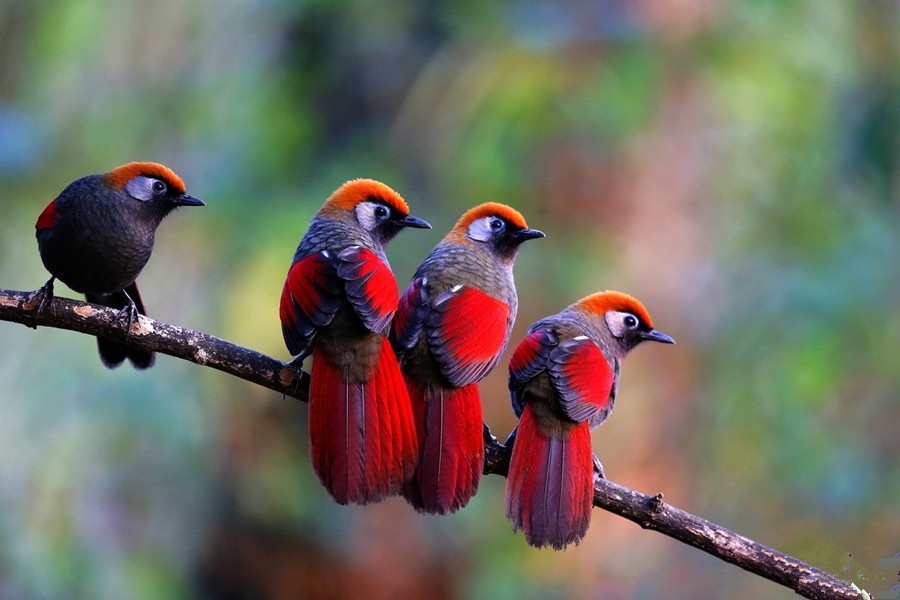
Birding Travel Tips for Baihualing and Gaoli Gongshan in West Yunnan
The Gaoligong Mountain region in Yunnan is one of China’s richest areas in terms of avian diversity, hosting 525 species of birds from 19 orders and 58 families. These birds account for 54.8% of Yunnan’s total bird species (958 species) and 37.5% of China’s total bird species (1400 species). Among them are the White-tailed Rubythroat (白尾梢虹雉), Golden Eagle (金雕), Black Vulture (黑兀鹫), Black-necked Crane (黑颈长尾雉), Blood Pheasant (血雉), Crested Bunting (红胸角雉), Green Peafowl (绿孔雀), Black Stork (黑鹳), Crested Argus (灰腹角雉), Red-crowned Crane (赤颈鹤), White Eared Pheasant (白鹇), Black Eared Pheasant (黑鹇), Crested Serpent Eagle (凤头鹰), and Sparrowhawk (雀鹰). These include 40 species classified as national first and second-level protected wildlife.
The Gaoligong Mountain area boasts a wide variety and large numbers of bird species, with concentrated distributions and vibrant plumage that captivates observers. Their calls vary greatly, adding to the area’s allure. With many ancient trade routes and former logging trails from before the establishment of protected areas, the region is easily traversed with expansive views and concentrated bird activity. It is one of Yunnan’s most classic birdwatching destinations and one of China’s prime locations for ecotourism centered on birdwatching, enjoying high international renown as a birdwatching destination. Among them, Baihualing is renowned as “China’s five-star birdwatching sanctuary.”
(一) Characteristics of Bird Resources in Gaoligong Mountain
(1) Vibrant Plumage
Walking from the Nujiang (or Longjiang) River Valley towards the mountain ridges, one can see birds of various colors such as red, yellow, cyan, blue, purple, black, white, brown, and tan, providing tourists with immense visual satisfaction.
Birds predominantly red in color include the Crimson Laughingthrush (male/赤红山椒鸟(雄)), Long-tailed Laughingthrush (male/长尾山椒鸟(雄)), Blood Pheasant (male/血雀(雄)), Red-billed Leiothrix (male/朱雀(雄)), and Yellow-bellied Sunbird(黄腰太阳鸟). Birds mainly yellow include the Black-headed Yellow Bulbul(黑枕黄鹂), Yellow Wagtail(黄鹡鸰), and Golden Bush Robin(金色林鸲). Those mainly green include the Chestnut-headed Bee-eater(栗喉蜂虎), Green Woodpecker(绿啄木鸟), Greater Yellownape(大拟啄木鸟), Wedge-tailed Green Pigeon(契尾绿鸠), and Crested Barbet(凤头鹦嘴鹎). Birds primarily blue include the Blue Rock Thrush(蓝矶鸫), Hill Blue Flycatcher(山蓝鹟), Verditer Flycatcher(铜蓝鹟), and Fairy Bluebird(仙鹟). The Violet Cuckoo(紫啸鸫) predominates in purple. Birds primarily black include the Large-billed Crow(大嘴乌鸦), Magpie Robin(鹩哥), Cormorant(鸬鹚), and Black Bulbul(黑卷尾). Those primarily white include the Intermediate Egret(中白鹭), Little Egret(白鹭), and Cattle Egret(牛背鹭). Birds with black and white interspersed plumage include the Magpie(喜鹊), Pied Bushchat(鹊鸲), Black-backed Forktail(黑背燕尾), Richard’s Pipit(白鹡鸰), and White Eared Pheasant(白鹇). Birds primarily gray include the Crane(灰鹤) and Gray-backed Shrike(灰卷尾). Most other birds (such as ducks, raptors, owls, larks, and many birds of the passerine order) are primarily brown or tan in color. These birds collectively form a colorful avian world in Gaoligong Mountain.
2. Melodious Bird Songs
The alternation of bird songs forms a beautiful symphony of the forest. The calls of the Himalayan tree pie are clear, light, and melodious like silver bells; the calls of species such as the black-headed sibia, purple cochoa, and black-backed forktail are sharp, trembling, and distinctive; the large Nuthatch’s song is loud and rugged, resembling rhythmic drum beats; even the monotonous calls of crows and hoopoes refuse to be lonely in the forest. Gaoligong Mountain, known as the “Kingdom of Laughingthrushes,” is renowned for its melodious and rhythmic songs that resonate throughout every corner of the forest. On the ridges, you can hear the red-tailed laughingthrush’s calls echoing from several kilometers away, calling and responding with companions. Through these calls, we can identify birds and also enjoy the endless pleasures of nature.
3. Varied Body Shapes
The birds in Gaoligong Mountain exhibit a wide range of body shapes. The smallest Yellow-browed Warbler weighs only over 5 grams, while the largest Vulture weighs up to 7500 grams, a difference of 1500 times. The shortest Gray-bellied Tesia measures only 8.6 cm long, whereas the longest Crane reaches up to 137 cm, a difference of nearly 16 times. There are also various ecological groups of birds with different body shapes, including waders, waterfowl, climbers, raptors, and songbirds.
4. Diverse and Colorful Pheasants
Yunnan is home to 28 species of pheasants, with 18 species found in Gaoligong Mountain alone, accounting for 64.3% of Yunnan’s pheasant species—a true “pheasant paradise”. Walking from the foot to the top of the mountain, one can see various pheasants such as the Green Peafowl (found along the Nujiang River), Quail (common in farmlands), and at the forest-farmland interface, the Hill Partridge and Barred-necked Hill Partridge are most common. Venturing into the forest, one can encounter the Blood Pheasant, White-cheeked Hill Partridge, Chestnut-throated Partridge, Gray-bellied Tragopan, Red-bellied Tragopan, White Eared Pheasant, Black Eared Pheasant, Kalij Pheasant, Long-tailed Sibia, and other diverse members of the pheasant family. As one ascends to the mountain peak, they enter the world of Blood Pheasants and Silver Pheasants. The high concentration of pheasant species in such a narrow zone is a biological wonder.
二、Gaoligong Mountain Birdwatching Season and Routes
Chinese Version: http://www.baoshandaily.com/html/20171204/content_54444.html

 7 Days GolfingTour
7 Days GolfingTour
 8 Days Group Tour
8 Days Group Tour
 8 Days Yunnan Tour
8 Days Yunnan Tour
 7 Days Shangri La Hiking
7 Days Shangri La Hiking
 11 Days Yunnan Tour
11 Days Yunnan Tour
 6 Days Yuanyang Terraces
6 Days Yuanyang Terraces
 11 Days Yunnan Tour
11 Days Yunnan Tour
 8 Days South Yunnan
8 Days South Yunnan
 7 Days Tea Tour
7 Days Tea Tour
 8 Days Muslim Tour
8 Days Muslim Tour
 12 Days Self-Driving
12 Days Self-Driving
 4 Days Haba Climbing
4 Days Haba Climbing
 Tiger Leaping Gorge
Tiger Leaping Gorge
 Stone Forest
Stone Forest
 Yunnan-Tibet
Yunnan-Tibet
 Hani Rice Terraces
Hani Rice Terraces
 Kunming
Kunming
 Lijiang
Lijiang
 Shangri-la
Shangri-la
 Dali
Dali
 XishuangBanna
XishuangBanna
 Honghe
Honghe
 Kunming
Kunming
 Lijiang
Lijiang
 Shangri-la
Shangri-la
 Yuanyang Rice Terraces
Yuanyang Rice Terraces
 Nujiang
Nujiang
 XishuangBanna
XishuangBanna
 Spring City Golf
Spring City Golf
 Snow Mountain Golf
Snow Mountain Golf
 Stone Mountain Golf
Stone Mountain Golf














